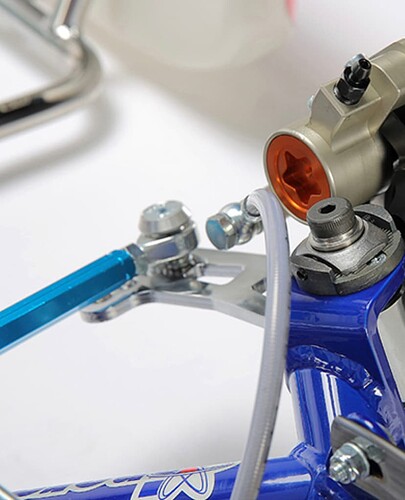As the title says, I get the feeling that Ackermann is massively misunderstood in how it applies to karting. It isn’t helped by chassis manufacturers suggesting that you can change Ackermann to get a different steering feel. I’m hoping to bring some clarity to this topic.
I’ll start by saying that Ackermann is a needed function to reduce front tire scrub, and that’s really its only function. It’s my personal opinion, but karts really shouldn’t have Ackermann adjustment in my opinion, and the rest of this post is how I come to that conclusion.
So, let’s start with the basics! Here’s a nice picture of what Ackermann is. Notice that the left tire is turned more than the right, for the vehicle to make a left turn. With your kart on the stand, you can visually see this as you turn your steering wheel that the inside front tire will turn more than the outside.

This is because the inside front tire will be on a tighter turning radius than the outside front tire. This effect is more pronounced for tighter turns.
With that in mind, there are three factors that contribute to the required Ackermann setup - front width, wheelbase, and toe. That’s it! The rest is designing a setup that always provides the correct amount of Ackermann regardless of how tight the corner is.
So, how does a kart provide Ackermann? Through the steering column and the spindles. In the below picture (taken from TKART, and edited) I draw some circles to help you visualize what’s happening.

On the graphic of the steering column, I’ve drawn two circles, a red and a yellow one. Before we get to the difference between them, notice the green arrows too. Notice how different the X-axis distances are for when the steering column rotates left versus right. Effectively this is how the kart achieves Ackermann, and the spindles play a part too (you can see the differences in those circles if you like). OTK was smart enough to only provide you the ability to make changes on the steering column, because I GUARANTEE they have thought this through given their stack of world championships ![]() Even then, they’re providing too much flexibility but we’ll get there.
Even then, they’re providing too much flexibility but we’ll get there.
With some math, you can figure out what angle each wheel needs to be turned at for any given corner radius, front track width, and wheelbase. I’ve done that using some standard numbers for wheelbase and front track width and plotted it vs. corner radius.
As expected, you can see that for tighter corner radii you need a bigger difference in angle of the inner wheel vs outer wheel as I described earlier. It seems to me that most kart track corner radii are between 14 meters and 28 meters, but I put data into the chart for more anyway.
The next step is plot the ratio between these two based on corner radii, which has a similar shape.
The green line is the correct ratio to have no scrub regardless of corner radius, the red line shows too much Ackermann (meaning the inside wheel will be turned too much), and the blue line shows too little Ackermann (meaning the inside wheel won’t be turned enough). This ratio is effectively how big the green arrows in the second graphic are compared to each other.
If you take a drastic example and say that the front track width is 0, your Ackermann ratio should be 1 regardless of corner radius since it’s effectively one wheel. If you take the opposite example and say your front track width is 20 feet, you have to have a massive amount of Ackermann because the inside wheel will be turning much sharper compared to the outside.
So, here’s why I say Ackermann shouldn’t be adjustable on karts. If we get back to a real example, let’s say you pull in your track width by 10mm on each side, which is a decent change. If you calculate how that Ackermann graph changes, it’s about a tenth of a percent difference for most corners. That’s really not even worth mentioning! The changes you can make on your kart’s steering column or spindles changes the Ackermann by much, much more. If you don’t believe me, change the setting on the steering column and see how much different the wheels turn when you turn the steering wheel! Toe alignment would require more of a change since with more toe-out you would technically want to take a little bit of Ackermann out in order to keep the ratio close to optimal, but again, we don’t have an adjustment small enough to do that on our karts.
There are definitely ways we could have finer Ackermann adjustment on karts, but in short, if the manufacturer does their math you should never need to adjust Ackermann. Those finer adjustments would be expensive anyhow ![]()
I hope this helped a bit.




